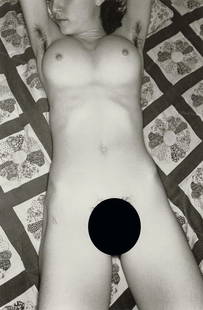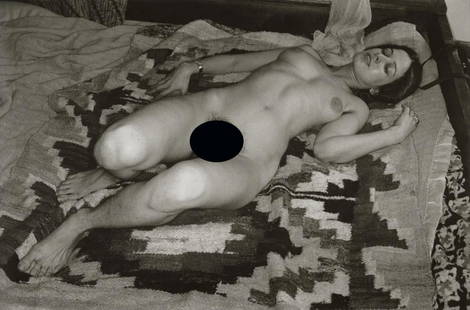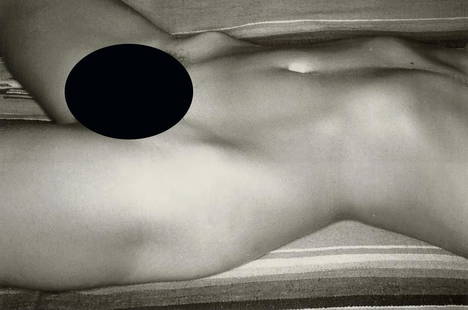
Edouard Manet - Olympia
Édouard Manet Sale History
View Price Results for Édouard Manet
Related Paintings
More Items from Édouard Manet
View MoreRecommended Art
View More


Item Details
Description
Original Etching and aquatint, 1867, with full margins, 6th State, unsigned and undated.
Size: 88 x 178 mms (Plate size) ; 265 x 198 mms (Paper size)
References: Harris no. 53, Guerin no. 39 ;
Edition: This was published in several works: 1867, Zola ; 1894 Dumont ; 1902 Duret ; 1905 StollinThe size of the edition is not known
Note: The location of the plate is unknown since 1905 when it was owned by Stollin and is believed to have been cancelled with a small hold, top and bottom. This is the second etched version of the infamous painting of 1863. (The previous one being Harris 52). Historical Note: "Shocking" was the word used to describe Edouard Manet's masterpiece (the version of our print in oil) when it was first unveiled in Paris in 1865. Olympia is a painting of a reclining nude woman, attended by a maid and a black cat, gazing mysteriously at the viewer. Why were visitors to the Paris gallery, already quite familiar with art featuring the naked body, so outraged by the painting that the gallery was forced to hire two policemen to protect the canvas? The objections to Olympia had more to do with the realism of the subject matter than the fact that the model was nude. The painting raised an unusually violent storm of protest. It is difficult for us today to understand the public's reaction. Its objections and repugnance even extended to the black cat, which in itself was considered perfectly outrageous. Visitors to the exhibition were so angry that the canvas had to be protected by attendants against the threat of violence. The critic of Le Constitutionnel 'was of course among the detractors. Even "advanced" critics failed to appreciate the painting. Jules Claretie and Theophile Gautier disliked it and said so in forthright terms. The painters themselves were divided over it. Courbet came out against it. Pissarro defended it; so did Degas. While Olympia's pose had classic precedents, the subject of the painting represented a prostitute. In the painting, the maid offers the courtesan a bouquet of flowers, presumably a gift from a client, not the sort of scene previously depicted in the art of the era. Viewers weren't sure of Manet's motives. Was he trying to produce a serious work of art? Was Olympia an attempt to parody other paintings? Or, worst of all, was he mocking them? Modern scholars believe Manet's technique further inflamed the controversy surrounding Olympia. Rejecting his traditional art training, Manet chose instead to paint with bold brush strokes, implied shapes, and vigourous, simplified forms. "The paint sat there on the surface of the canvas...It wasn't just the fact that she's a nude and she's a lower class nude, but also the fact that she was painted in...what many people read as almost childish or unskilled fashion," explains art historian Anne McCauley in the film. "Olympia shocked in every possible way. That is to say formally, morally, in terms of its subject matter. The artist was the only one of his contemporaries who didn't have to sell his paintings to earn a living. He enjoyed the benefits of his social position -- living where he chose and keeping company with cultural icons of the time. "He felt that French culture was his culture. What was in the Louvre was part of his history. With all his privilege, Manet was still driven to prove himself to his father, who wanted his son to study law. The artist was an ambitious man, who also sought acceptance at the Salon, France's annual, government-sponsored art show, and the National Art Academy, the Academie des Beaux-Arts. In 1863 -- the same year he painted Olympia -- Manet submitted his painting Déjeuner sur l'herbe, or Luncheon on the Grass, to the Salon. This large, provocative painting, depicting clothed men picnicking outdoors with a naked woman, was rejected by the jury. When it was finally shown publicly that same year, it elicited a similarly negative response from the masses. Manet waited two years before submitting Olympia to the Salon. Much to Manet's surprise, the jury accepted his bold, new work. Many scholars believe that Olympia was admitted to the Salon because jurors didn't want to be accused of censorship following the strong negative reaction to Déjeuner. Instead, they decided to expose the artist and his work to the wrath of the real critics -- the public. As expected, Manet was vilified by Salon-goers. Although he succeeded in his goal to change the face of French painting, Manet was devastated by the merciless criticism. "They are raining insults on me. Someone must be wrong," the artist wrote to his friend, French poet Charles Pierre Baudelaire. Manet based the Olympia's composition on The Venus of Urbino, one of the famous masterpieces by the Italian painter Titian. Bracquemond often lent assistance to his painter friends when they took up etching. He attended to the biting of Corot's plates; he helped Manet and Pissarro in the practice of aquatint. For Manet's etching of Olympia, Bracquemond is supposed to have worked on the final states of the copper plate. Five or six states (the exact number is uncertain) were thought necessary to perfect the needling of the plate. In the fourth state, the plate was cut down on both left and right in order to eliminate a vertical strip on both sides which had not been needled. In the final state, the woman's hand on her lower belly was slightly reworked in order to bring out its contours.
Public Collections: Metropolitam Museum of Art, New York - Accession Number: 1983.1093
Size: 88 x 178 mms (Plate size) ; 265 x 198 mms (Paper size)
References: Harris no. 53, Guerin no. 39 ;
Edition: This was published in several works: 1867, Zola ; 1894 Dumont ; 1902 Duret ; 1905 StollinThe size of the edition is not known
Note: The location of the plate is unknown since 1905 when it was owned by Stollin and is believed to have been cancelled with a small hold, top and bottom. This is the second etched version of the infamous painting of 1863. (The previous one being Harris 52). Historical Note: "Shocking" was the word used to describe Edouard Manet's masterpiece (the version of our print in oil) when it was first unveiled in Paris in 1865. Olympia is a painting of a reclining nude woman, attended by a maid and a black cat, gazing mysteriously at the viewer. Why were visitors to the Paris gallery, already quite familiar with art featuring the naked body, so outraged by the painting that the gallery was forced to hire two policemen to protect the canvas? The objections to Olympia had more to do with the realism of the subject matter than the fact that the model was nude. The painting raised an unusually violent storm of protest. It is difficult for us today to understand the public's reaction. Its objections and repugnance even extended to the black cat, which in itself was considered perfectly outrageous. Visitors to the exhibition were so angry that the canvas had to be protected by attendants against the threat of violence. The critic of Le Constitutionnel 'was of course among the detractors. Even "advanced" critics failed to appreciate the painting. Jules Claretie and Theophile Gautier disliked it and said so in forthright terms. The painters themselves were divided over it. Courbet came out against it. Pissarro defended it; so did Degas. While Olympia's pose had classic precedents, the subject of the painting represented a prostitute. In the painting, the maid offers the courtesan a bouquet of flowers, presumably a gift from a client, not the sort of scene previously depicted in the art of the era. Viewers weren't sure of Manet's motives. Was he trying to produce a serious work of art? Was Olympia an attempt to parody other paintings? Or, worst of all, was he mocking them? Modern scholars believe Manet's technique further inflamed the controversy surrounding Olympia. Rejecting his traditional art training, Manet chose instead to paint with bold brush strokes, implied shapes, and vigourous, simplified forms. "The paint sat there on the surface of the canvas...It wasn't just the fact that she's a nude and she's a lower class nude, but also the fact that she was painted in...what many people read as almost childish or unskilled fashion," explains art historian Anne McCauley in the film. "Olympia shocked in every possible way. That is to say formally, morally, in terms of its subject matter. The artist was the only one of his contemporaries who didn't have to sell his paintings to earn a living. He enjoyed the benefits of his social position -- living where he chose and keeping company with cultural icons of the time. "He felt that French culture was his culture. What was in the Louvre was part of his history. With all his privilege, Manet was still driven to prove himself to his father, who wanted his son to study law. The artist was an ambitious man, who also sought acceptance at the Salon, France's annual, government-sponsored art show, and the National Art Academy, the Academie des Beaux-Arts. In 1863 -- the same year he painted Olympia -- Manet submitted his painting Déjeuner sur l'herbe, or Luncheon on the Grass, to the Salon. This large, provocative painting, depicting clothed men picnicking outdoors with a naked woman, was rejected by the jury. When it was finally shown publicly that same year, it elicited a similarly negative response from the masses. Manet waited two years before submitting Olympia to the Salon. Much to Manet's surprise, the jury accepted his bold, new work. Many scholars believe that Olympia was admitted to the Salon because jurors didn't want to be accused of censorship following the strong negative reaction to Déjeuner. Instead, they decided to expose the artist and his work to the wrath of the real critics -- the public. As expected, Manet was vilified by Salon-goers. Although he succeeded in his goal to change the face of French painting, Manet was devastated by the merciless criticism. "They are raining insults on me. Someone must be wrong," the artist wrote to his friend, French poet Charles Pierre Baudelaire. Manet based the Olympia's composition on The Venus of Urbino, one of the famous masterpieces by the Italian painter Titian. Bracquemond often lent assistance to his painter friends when they took up etching. He attended to the biting of Corot's plates; he helped Manet and Pissarro in the practice of aquatint. For Manet's etching of Olympia, Bracquemond is supposed to have worked on the final states of the copper plate. Five or six states (the exact number is uncertain) were thought necessary to perfect the needling of the plate. In the fourth state, the plate was cut down on both left and right in order to eliminate a vertical strip on both sides which had not been needled. In the final state, the woman's hand on her lower belly was slightly reworked in order to bring out its contours.
Public Collections: Metropolitam Museum of Art, New York - Accession Number: 1983.1093
Condition
Generally in good condition with minor foxing and foldingon edge of margins. Paper loss on left hand bottom margin - framed
Buyer's Premium
- 0%
Edouard Manet - Olympia
Estimate $1,800 - $2,500
2 bidders are watching this item.
Get approved to bid.
Shipping & Pickup Options
Item located in London, ukSee Policy for Shipping
Payment

Fairhead Fine Art Ltd
London, United KingdomTOP

















































































